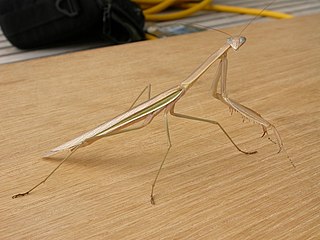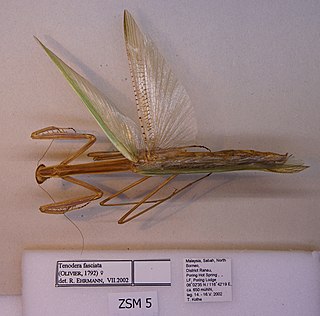
The Chinese mantis is a species of mantis native to Asia and the nearby islands. In 1896 this species was accidentally introduced by a nurseryperson at Mt. Airy near Philadelphia, United States. Tenodera sinensis often is erroneously referred to as Tenodera aridifolia sinensis because it was at first described as a subspecies of Tenodera aridifolia, but Tenodera sinensis is now established as a full species.

Mantidae is one of the largest families in the order of praying mantises, based on the type species Mantis religiosa; however, most genera are tropical or subtropical. Historically, this was the only family in the order, and many references still use the term "mantid" to refer to any mantis. Technically, however, "mantid" refers only to members of the family Mantidae, and not the 14 remaining families of mantises. Some of the most recent classifications have promoted a number of the mantid subfamilies to the rank of family, e.g. Iridopterygidae, Sibyllidae, Tarachodidae, Thespidae, and Toxoderidae, while other classifications have reduced the number of subfamilies without elevating to higher rank.

Cannibalism is the act of consuming another individual of the same species as food. Cannibalism is a common ecological interaction in the animal kingdom and has been recorded in more than 1,500 species. Human cannibalism is well documented, both in ancient and in recent times.

Actias is a genus of Saturniid moths, which contains the Asian-American moon moths. Long tails on their hindwings are among their distinctive traits. Other moths with similar appearance are Copiopteryx, Argema and Eudaemonia.

Sexual cannibalism is when an animal, usually the female, cannibalizes its mate prior to, during, or after copulation. It is a trait observed in many arachnid orders and several insect orders. Several hypotheses to explain this seemingly paradoxical behavior have been proposed. The adaptive foraging hypothesis, aggressive spillover hypothesis and mistaken identity hypothesis are among the proposed hypotheses to explain how sexual cannibalism evolved. This behavior is believed to have evolved as a manifestation of sexual conflict, occurring when the reproductive interests of males and females differ. In many species that exhibit sexual cannibalism, the female consumes the male upon detection. Females of cannibalistic species are generally hostile and unwilling to mate; thus many males of these species have developed adaptive behaviors to counteract female aggression.

Tenodera angustipennis is a species of mantis native to Asia and nearby areas of Oceania. The species was introduced and became established in the eastern United States. Tenodera angustipennis was noticed as early as 1921 in Aberdeen, Maryland, but that occurrence was not noted in a published record until 1933.

Sang piao xiao or Sangpiaoxiao is a Pinyin transliteration referring to the oothecae, or egg case, of the praying mantis as an ingredient in traditional Chinese medicine. A formula based on this ingredient is known as sang piao xiao san and is also known as "mantis formula" in English. The formula may also be sold as a pill.

A gazelle is one of many antelope species in the genus Gazella. This article also deals with the seven species included in two further genera, Eudorcas and Nanger, which were formerly considered subgenera of Gazella. A third former subgenus, Procapra, includes three living species of Asian gazelles.

Tenodera australasiae, the purple-winged mantis, is species of praying mantis. Found in Australia, it is common in most parts of Brisbane (QLD). Both males and females are capable of flight. The species has not been shown to be parthenogenetic.

Mantises are an order (Mantodea) of insects that contains over 2,400 species in about 460 genera in 33 families. The largest family is the Mantidae ("mantids"). Mantises are distributed worldwide in temperate and tropical habitats. They have triangular heads with bulging eyes supported on flexible necks. Their elongated bodies may or may not have wings, but all Mantodea have forelegs that are greatly enlarged and adapted for catching and gripping prey; their upright posture, while remaining stationary with forearms folded, has led to the common name praying mantis.

Tenodera fasciata is a species of mantis in the family Mantidae.
Tenodera superstitiosa is a species in the family Mantidae.
Tenodera acuticauda is a species of mantis in the family Mantidae.

Miridiba is a genus of beetles in the family Scarabaeidae, which are known for their white larvae that feed on the roots of plants. The antennae end in a short club. The mandible has a wrinkled molar lobe and the incisor lobe is depressed above. The labrum is depressed in the middle. Species within this genus are found in the Old World, mainly in eastern and tropical Asia. Many species in the genus were earlier placed in the genus Holotrichia.
Differential fitness is the third of Darwin's four postulates for natural selection. It states that survival and reproduction rates vary between individuals. Fitness differentals are widespread and detectable throughout nature. This fitness differential is visible in several ways, and it can be detected throughout nature. It can be based on behavioral differences that can act with or against environmental changes; one notable example was a 2014 study of snowshoe hares, where researchers found that white snowshoe hares did not change their behavior due to increased snow melt. Subsequent research found that brown hares survived and bred more than the white snowshoe hares. Differential fitness can also be applied between species. Researchers found that the Neotoma macrotis wood rat in the California woodlands was responding to climate change by moving into a hybrid zone, and this gave it an advantage over the competing Neotoma fuscipes Differential fitness can also apply to multiple traits at once and at unequal levels. A study with Linum pubescens found that its floral traits were based on multiple different fitness factors. Differential fitness can also be based on the sex of organisms. Researchers found that there were differential survival rates between mothers and fathers in the mid-nineteenth century in Utah.
Hemicriconemoides is a genus of nematodes belonging to the family Criconematidae.











